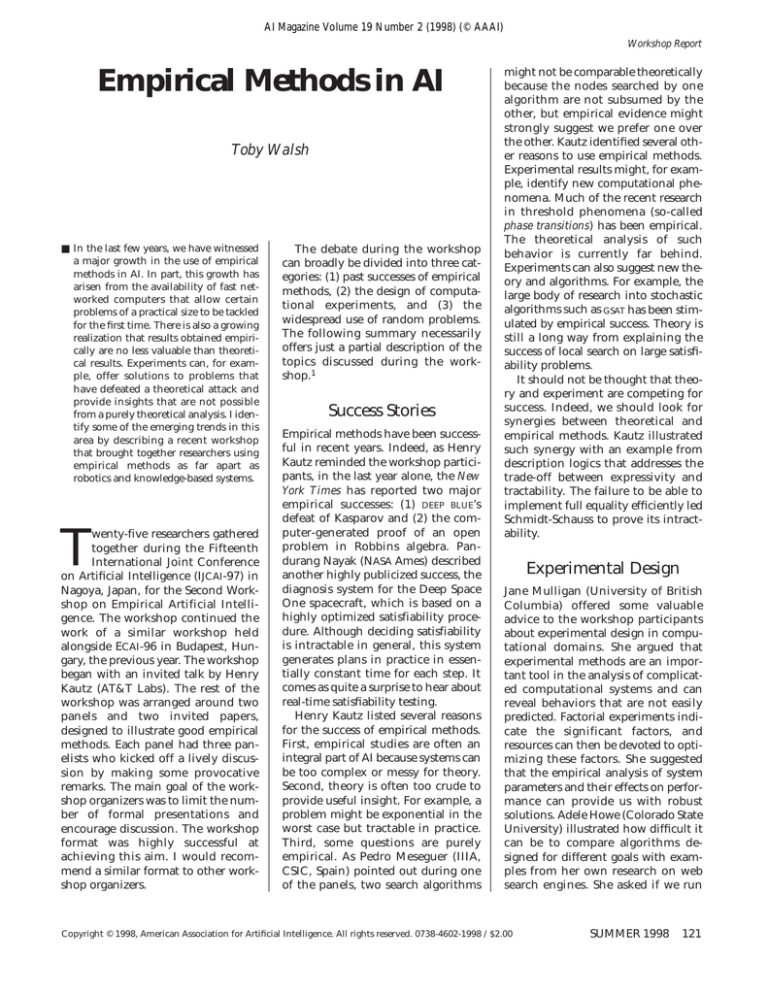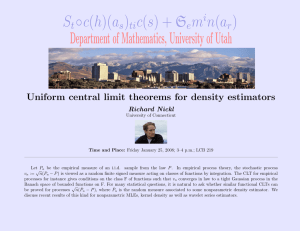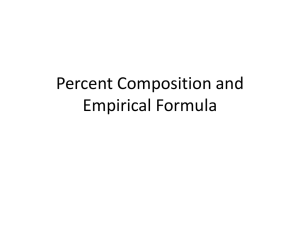
AI Magazine Volume 19 Number 2 (1998) (© AAAI)
Workshop Report
Empirical Methods in AI
Toby Walsh
■ In the last few years, we have witnessed
a major growth in the use of empirical
methods in AI. In part, this growth has
arisen from the availability of fast networked computers that allow certain
problems of a practical size to be tackled
for the first time. There is also a growing
realization that results obtained empirically are no less valuable than theoretical results. Experiments can, for example, offer solutions to problems that
have defeated a theoretical attack and
provide insights that are not possible
from a purely theoretical analysis. I identify some of the emerging trends in this
area by describing a recent workshop
that brought together researchers using
empirical methods as far apart as
robotics and knowledge-based systems.
T
wenty-five researchers gathered
together during the Fifteenth
International Joint Conference
on Artificial Intelligence (IJCAI-97) in
Nagoya, Japan, for the Second Workshop on Empirical Artificial Intelligence. The workshop continued the
work of a similar workshop held
alongside ECAI-96 in Budapest, Hungary, the previous year. The workshop
began with an invited talk by Henry
Kautz (AT&T Labs). The rest of the
workshop was arranged around two
panels and two invited papers,
designed to illustrate good empirical
methods. Each panel had three panelists who kicked off a lively discussion by making some provocative
remarks. The main goal of the workshop organizers was to limit the number of formal presentations and
encourage discussion. The workshop
format was highly successful at
achieving this aim. I would recommend a similar format to other workshop organizers.
The debate during the workshop
can broadly be divided into three categories: (1) past successes of empirical
methods, (2) the design of computational experiments, and (3) the
widespread use of random problems.
The following summary necessarily
offers just a partial description of the
topics discussed during the workshop.1
Success Stories
Empirical methods have been successful in recent years. Indeed, as Henry
Kautz reminded the workshop participants, in the last year alone, the New
York Times has reported two major
empirical successes: (1) DEEP BLUE’s
defeat of Kasparov and (2) the computer-generated proof of an open
problem in Robbins algebra. Pandurang Nayak (NASA Ames) described
another highly publicized success, the
diagnosis system for the Deep Space
One spacecraft, which is based on a
highly optimized satisfiability procedure. Although deciding satisfiability
is intractable in general, this system
generates plans in practice in essentially constant time for each step. It
comes as quite a surprise to hear about
real-time satisfiability testing.
Henry Kautz listed several reasons
for the success of empirical methods.
First, empirical studies are often an
integral part of AI because systems can
be too complex or messy for theory.
Second, theory is often too crude to
provide useful insight. For example, a
problem might be exponential in the
worst case but tractable in practice.
Third, some questions are purely
empirical. As Pedro Meseguer (IIIA,
CSIC, Spain) pointed out during one
of the panels, two search algorithms
might not be comparable theoretically
because the nodes searched by one
algorithm are not subsumed by the
other, but empirical evidence might
strongly suggest we prefer one over
the other. Kautz identified several other reasons to use empirical methods.
Experimental results might, for example, identify new computational phenomena. Much of the recent research
in threshold phenomena (so-called
phase transitions) has been empirical.
The theoretical analysis of such
behavior is currently far behind.
Experiments can also suggest new theory and algorithms. For example, the
large body of research into stochastic
algorithms such as GSAT has been stimulated by empirical success. Theory is
still a long way from explaining the
success of local search on large satisfiability problems.
It should not be thought that theory and experiment are competing for
success. Indeed, we should look for
synergies between theoretical and
empirical methods. Kautz illustrated
such synergy with an example from
description logics that addresses the
trade-off between expressivity and
tractability. The failure to be able to
implement full equality efficiently led
Schmidt-Schauss to prove its intractability.
Experimental Design
Jane Mulligan (University of British
Columbia) offered some valuable
advice to the workshop participants
about experimental design in computational domains. She argued that
experimental methods are an important tool in the analysis of complicated computational systems and can
reveal behaviors that are not easily
predicted. Factorial experiments indicate the significant factors, and
resources can then be devoted to optimizing these factors. She suggested
that the empirical analysis of system
parameters and their effects on performance can provide us with robust
solutions. Adele Howe (Colorado State
University) illustrated how difficult it
can be to compare algorithms designed for different goals with examples from her own research on web
search engines. She asked if we run
Copyright © 1998, American Association for Artificial Intelligence. All rights reserved. 0738-4602-1998 / $2.00
SUMMER 1998
121
Workshop Report
One topic of great debate
at this workshop was the
widespread use of random
problems in empirical
studies.
the risk of bias because algorithm
designers also usually perform the
experiments and suggested that we
should give people incentives to work
on shared problems. High-profile
competitions are one such incentive.
Finally, she proposed the web as a
good medium to make code and
benchmarks available. Bernhard Nebel
(Albert Ludwigs-Universität Freiburg)
cataloged some of the problems that
arise when comparing systems that are
different in design. For example, central processing unit and memory use
might be about the only way to compare graph planners and satisfiability
planners. It is also not obvious how
you compare systems that solve slightly different problems. For example,
one planner might guarantee to return
optimal plans, but another returns
you any plan, and the third only
returns plans of some fixed length.
You also have to be careful about the
choice of encoding because this choice
can change the problem being solved.
Finally, benchmark problems might
have some feature such as symmetry
that favors a particular approach.
Meseguer questioned how we
should measure search cost. Because
means alone are not satisfactory, how
many statistics should we record? Are
there implementation-independent
measures we can collect (for example,
the number of accesses to data structures)? Finally, he asked how we
choose a benchmark. Should we separate soluble from insoluble problems?
Do we just use problems from the middle of the phase transition? He suggested that benchmarks should
include qualitatively different classes
from the problem spectrum.
122
AI MAGAZINE
Random Problems
One topic of great debate at this (and,
indeed, the previous) workshop was
the widespread use of random problems in empirical studies. Research
into phase-transition behavior has
identified hard instances of random
problems that are now routinely used
to benchmark algorithms. Problems
that are obviously overconstrained—
or underconstrained—tend to be
much easier to solve than critically
constrained problems from around
the phase transition in solubility. To
counter Nayak’s claim that he had
never found a phase transition in reallife problems, Toby Walsh (University
of Strathclyde) offered two examples:
The first was an aircraft-scheduling
problem for American Airlines, where
the economics ensured that the problem was critically constrained in the
number of aircraft. The second example was scheduling tracks at Gare de
Lyon, where the problem proved to be
so critically constrained that only a
hardware interlock prevented a daily
crash. John Slaney (Australian National University) and Sylvi Thiébaux
(IRISA Rennes, France) then raised
some interesting questions about
phase-transition behavior in optimization problems (“what is the minimum-cost solution?”) and its relationship to phase-transition behavior in
the corresponding decision problems
(“does a solution exist of cost less than
some specified value?”). Using random blocks world planning instances
as an example, they showed that the
optimization problem might have a
peak in hardness at a different point
than the peak for the decision problem (typically, the peak in hardness for
the decision problem is where about
50 percent or so of the problems have
solutions) and offered some analysis of
why this is so.
Jeremy Frank (NASA Ames) listed
some of the pitfalls of using random
problems. For example, some distributions give problems that are artificially
easy, but random-number generators
can be less random than we would like
(especially when we are using them to
generate just a single random bit).
Meseguer also questioned if random
models like that used by the constraint-satisfaction community are
representative of real problems. Ullrich Hustadt (MPI, Saarbrücken) proposed that we should look for random
problems that are natural (that is, they
are similar to real problems met in
practice), hard (that is, they are computationally expensive to solve), and
interesting (that is, they should discriminate between our procedures).
Unfortunately, it is usually hard to
find all three properties.
Kautz suggested that we should add
more structure into our random problems to make them more realistic. He
offered quasigroup completion as a
random problem with more structure.
Walsh made a similar suggestion,
proposing the use of pseudoreal problems. That is, we take real problems and
perturb them randomly. We then have
the benefit of large samples (as with
random problems) and lots of structures (as with real problems). Of course,
the question of how to choose base
problems, and how to perturb them, is
still left open. Finally, David Poole
(University of British Columbia) had a
more radical suggestion. He argued
that the reason we can cope with the
real world is its structure. Indeed, if it
were completely random, we would
not survive. AI should therefore be
about exploiting structure in problems.
He suggested that we need to find real
problems in which structure can be
exploited. Indeed, there might be
much more structure than we would
dare to put into a random experiment
and claim that it is realistic.
Conclusions
The use of empirical methods in AI is
flourishing at present. As the debate
during this workshop illustrated, there
C&
Thought
omputers
Edward A. Feigenbaum
& Julian Feldman
EDITORS
ISBN 0-262-56092-5
560 pp., index. $18.00 softcover
The AAAI Press • Distributed by The MIT Press
Massachusetts Institute of Technology, 5 Cambridge Center, Cambridge, Massachusetts 02142
To order, call toll free: (800) 356-0343 or (617) 625-8569.
MasterCard and VISA accepted.
Workshop Report
are many fine examples of results won
through the use of empirical methods.
Although experimentalists face many
of the traditional problems found in
other empirical sciences, there are several features of computational experiments that raise novel problems: For
example, how do we measure performance in a machine- or implementation-independent way? The existence of a successful workshop series
such as this one demonstrates that the
field is facing up to such challenges.
We should not rest on our laurels
because good experimental practice is
still being established in many areas.
Nevertheless, the workshop allowed
for a healthy dialogue between participants in diverse fields. It would, for
example, be wrong to conclude that
random problems will continue to be
a major debating point. Indeed, it was
agreed that the call for the next workshop would state that random problems is one topic that will not be discussed. I look forward to the next
workshop, which will be held on 24
August 1998 as part of the Thirteenth
European Conference on Artificial
Intelligence (ECAI-98). Full details and
an application form to attend the
workshop are available from dream.
dai.ed.ac.uk/group/tw/ecai98.html.
Note
1. See dream.dai.ed.ac.uk/group/tw/ijcai97.
html for the call for participation.
Toby Walsh is a research
fellow in the Department of Computer Science at the University of
Strathclyde and an honorary fellow in the
Department of Artificial
Intelligence at Edinburgh University. He
received his B.A. from the University of
Cambridge and his M.Sc. and Ph.D. from
Edinburgh University. He has been a MarieCurie postdoctoral fellow at INRIA (Nancy,
France) and IRST (Trento, Italy) and an
SERC postdoctoral fellow in the Department of Artificial Intelligence at Edinburgh. He is a founding member of the APES
research group, a cross-university group of
researchers dedicated to improving the use
of empirical methods within AI (see
www.cs.strath.ac.uk/Contrib/ipg/apes.
html for more details). His e-mail address is
tw@dai.ed.ac.uk.
124
AI MAGAZINE
New Proceedings from AAAI Press
Proceedings of the Fourth International Conference
on Artificial Intelligence Planning Systems
Edited by Reid Simmons, Manuela Veloso, and Stephen Smith
244 pp., 8-1/2 x 11 inches, index. $40.00. ISBN 1-57735-052-9
The International Conference on Artificial Intelligence Planning Systems (AIPS) continues as the premier conference for showcasing new results in planning research.
AIPS brings together AI researchers in all aspects of problems in planning, scheduling, planning and learning, and plan execution for dealing with complex problems.
Papers in this proceedings range from new theoretical frameworks and algorithms for
planning to practical implemented applications in a variety of domains.
Proceedings of the Eleventh International
Florida Artificial Intelligence Research
Symposium Conference
Edited by Diane Cook
504 pp., 8-1/2 x 11 inches, index. $55.00. ISBN 1-57735-051-0
FLAIRS was founded in 1987 to promote and advance artificial intelligence research
within the state of Florida, fostering interaction between researchers at colleges, universities, and industry. Since 1990, FLAIRS conferences have been broadened to
include participants and papers from across North America and the world. This year’s
proceedings covers a wide range of algorithms, methodologies, and applications, featuring topics in uncertainty reasoning, natural language processing, machine learning, expert systems, knowledge representation, data mining, theorem proving, and
AI education, with a variety of applications in areas such as accident prevention education, military planning, simulated race cars, and computer bridge.
Proceedings of the Sixth International Conference
on Intelligent Systems for Molecular Biology
Edited by Janice Glasgow, Tim Littlejohn, François Major Richard Lathrop,
David Sankoff, and Christoph Sensen
234 pp., 8-1/2 x 11 inches, index. $40.00. ISBN 1-57735-053-7
As with the previous ISMB conferences, this meeting provides a general forum for disseminating the latest developments in bioinformatics. ISMB is a multidisciplinary
conference that brings together scientists from computer science, molecular biology,
mathematics, and statistics. Its scope includes the development and application of
advanced computational methods for biological problems. Relevant computational
techniques include, but are not limited to machine learning, pattern recognition,
knowledge representation, databases, combinatorics, stochastic modeling, string and
graph algorithms, linguistic methods, robotics, constraint satisfaction, and parallel
computation. Biological areas of interest include molecular structure, genomics,
molecular sequence analysis, evolution and phylogenetics, metabolic pathways, regulatory networks, developmental control, and molecular biology generally. Emphasis
is placed on the validation of methods using real data sets, practical applications in
the biological sciences, and development of novel computational techniques.
To order, call 650-328-3123
or send e-mail to orders@aaai.org.
For further information visit our web site at
www.aaai.org/Press/
Published by The AAAI Press
445 Burgess Drive
Menlo Park, CA 94025







